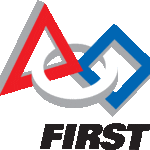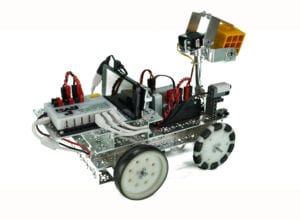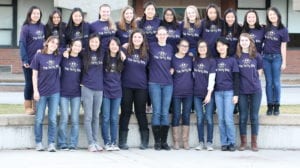With the 2015/2016 FIRST® Tech Challenge (FTC®) season kicking off September 12, 2015, students, parents, and mentors can expect significant technology changes to the popular robotics program designed for students in grades 7-12.
FIRST has made a critical decision to switch from LEGO’s NXT platform to Android’s popular operating system and devices. This means that students will now have access to a more powerful and flexible system that is used in classrooms, companies, and in the do-it-yourself community around the world. The Android platform gets high marks for being affordable, having powerful smartphones, and providing off-the-shelf robotics components.
I got in touch with FIRST to ask what their expectations were for the new platform and how the changes will impact students’ experiences.
“The new FIRST Tech Challenge platform is a game changer – it will change the way students view and use the mobile technology that is sitting in their pocket,” said Donald E. Bossi, president of FIRST and MIT alum. “FIRST and Qualcomm collaborated to bring this power to FIRST Tech Challenge so our students could gain real-world experience in robotics programming,” Bossi continued. “Java is the most popular language taught in high school, and the native language used in Android development – the most popular mobile operating system around the globe. This gives FIRST Tech Challenge students a competitive advantage as they complete their Java work in school and prepare for more tech experiences in college and, eventually, the workforce.”
“In past years, teams chose from LabVIEW or RobotC,” Bossi explained. “LabVIEW is an icon-based language and RobotC is a text based language around C programming. In the new Snapdragon/Android based system, teams will also have an icon-based option via FIRST Tech Challenge App Inventor using a Blockly style interface. They can also use Java, via Android Studio, as a text-based option,” he continued. “Both options will allow teams to develop Android Apps that run on the super-fast Snapdragon/Android platform. FIRST Tech Challenge teams will become App developers while still in high school!”
The following new capabilities have been integrated into the FTC platform.

1) Android platform. The Android platform offers a robust set of features integrated into Android smartphones for the robot controller and user console including: processing and memory, user interface, built in sensors, and programming options. The Android platform and Android devices are available around the world and are aligned with the increasing number of non-proprietary options for FTC teams.
2) Java programming. Android’s native programming environment is Java. FIRST teams will have several Java options including a basic Application (App) that includes a configuration wizard, full text based Java programming, and MIT App Inventor. Java and MIT App Inventor are praised as being easier to use and more robust languages and will better prepare students for future opportunities. Teams will no longer use RobotC or LabVIEW.
3) More powerful processors. The new Snapdragon processors, developed by Qualcomm, will allow teams to have more complex code and use better sensors that can grab more data points per second.
Although the platform has changed, teams can continue to use all of their existing FTC hardware, sensors, and electronics, and will transition to the new platform using a simple interface (the Legacy Module) between Android devices and their existing sensors and motor controllers.
What Teams Can Expect: Feedback From a Beta Test Team
This past spring, FIRST had teams test the new platform and provide critical feedback and recommendations. I talked with one of the beta test teams, The Parity Bits (Team #8379) about their experience. Kara Luo (programmer), Emily Nadler (head of build), and Eula Zhong (programmer) were kind enough to share their input.
There were quite a few things about the new system the team enjoyed. Speed and ruggedness were at the top of the list. They said the connection was much faster with the Android-based system. Emily Nadler, one of the drivers, said, “If a certain frequency is busy, you can move to another. If you’re wondering how long it takes for messages to be sent to the robot, you can look at ping times.”

Emily also thought the new Android system and devices were more user-friendly and natural to use. Programmer Kara Luo added, “Everything is fairly intuitive as most people are used to using smartphones, and information about app development and Java are very accessible online, making debugging very simple.” She also liked that the Android phones had a few built-in sensors (such as gyroscopes, accelerometers and cameras) that could be accessed through code.
Team members were also happy to see that ROBOTC was being replaced with Java. Programmer Eula Zhong pointed out that “Java has a more mature online support community and wider real-world applications which are beneficial for students in the future.”
They all agreed that the new capabilities will improve the student experience with FTC and make the competing process smoother. “The fact that teams themselves will be able to control the connection of the driver station and the robot may be more reassuring for the students,” Kara shared. “Additionally, the development process will be more exciting as students will be able to explore more fields and draw more connections between coding for robotics and software development elsewhere, as Java is a much more common language than ROBOTC, and students will be able to work with app development, if they wish.”
Transition to the New Platform
The team said that the transition to the new platform was simple and expects it should be smooth and quick for well-established teams.
To learn how to set up different parts of the hardware system and the Android devices, watch a brief video created by The Parity Bits.
Kara felt like the transition was more software-heavy than hardware. “If teams have previous knowledge of Java and Android app development, then the transition will merely be a matter of reading through the manual, understanding the sample code, and applying the knowledge to construct your own code.” Kara added, “However, if teams have not used Java before, there are tutorials online that can provide enough Java knowledge to make writing the code possible.”
All three team members agreed that the beta testing process was a positive experience and that FIRST and their affiliates were great about listening to their comments and concerns. “During the process, we kept in touch with the developers and Mass FTC. We encountered problems in hardware connection, software, Android Studio, and many other different issues, reported them back to the developers at FIRST, and then we got responses from the developers,” explained Eula. “They were looking for problems that a team might encounter during the season and we were able to assist them with our experience.”
To learn more about the new FIRST Tech Challenge technology platform and for general information about the robotics program, visit these links:
1) FIRST’s press release about the new Android platform
2) FAQs about the platform and what you need to purchase
3) Learn more about FIRST Tech Challenge
4) Learn how to start a team
About FIRST®
Accomplished inventor Dean Kamen founded FIRST® (For Inspiration and Recognition of Science and Technology) in 1989 to inspire an appreciation of science and technology in young people. Based in Manchester, N.H., FIRST designs accessible, innovative programs to build self-confidence, knowledge, and life skills while motivating young people to pursue opportunities in science, technology, and engineering. With support from over 200 of the Fortune 500 companies and more than $22 million in college scholarships, the not-for-profit organization hosts the FIRST® Robotics Competition (FRC® ) for students in Grades 9-12; FIRST® Tech Challenge (FTC® ) for Grades 7-12; FIRST® LEGO® League (FLL® ) for Grades 4-8; and Junior FIRST® LEGO® League (Jr.FLL®) for Grades K-3. Gracious Professionalism® is a way of doing things that encourages high-quality work, emphasizes the value of others, and respects individuals and the community. To learn more about FIRST, go to www.usfirst.org.







